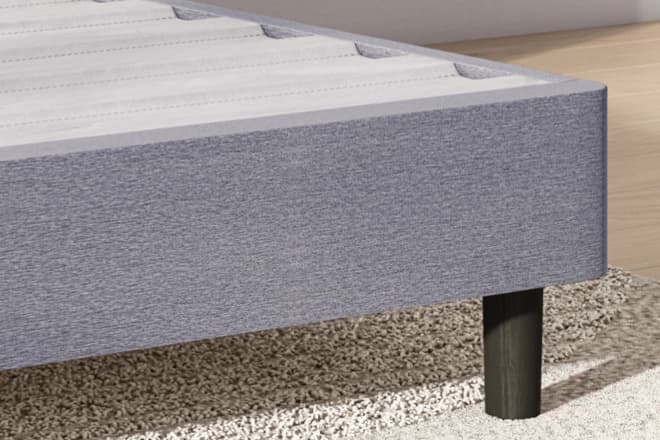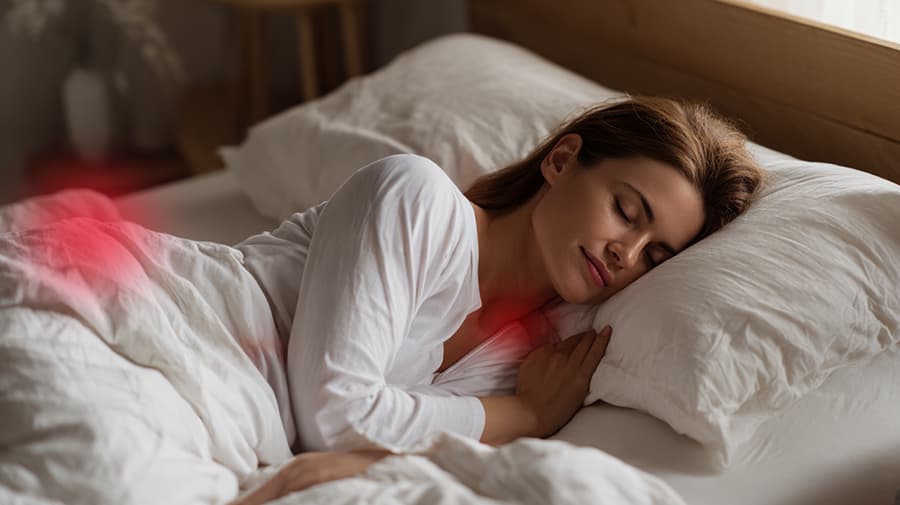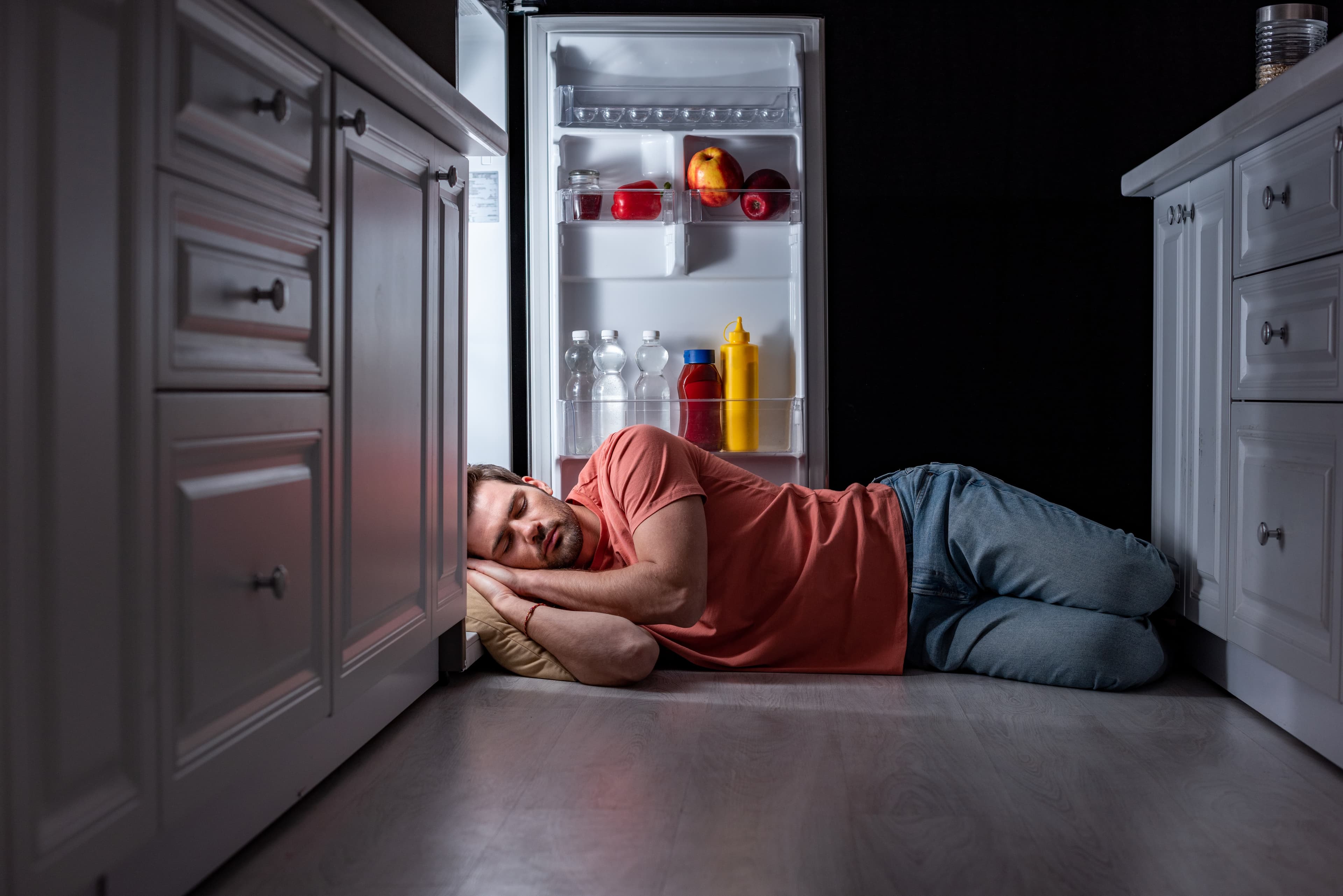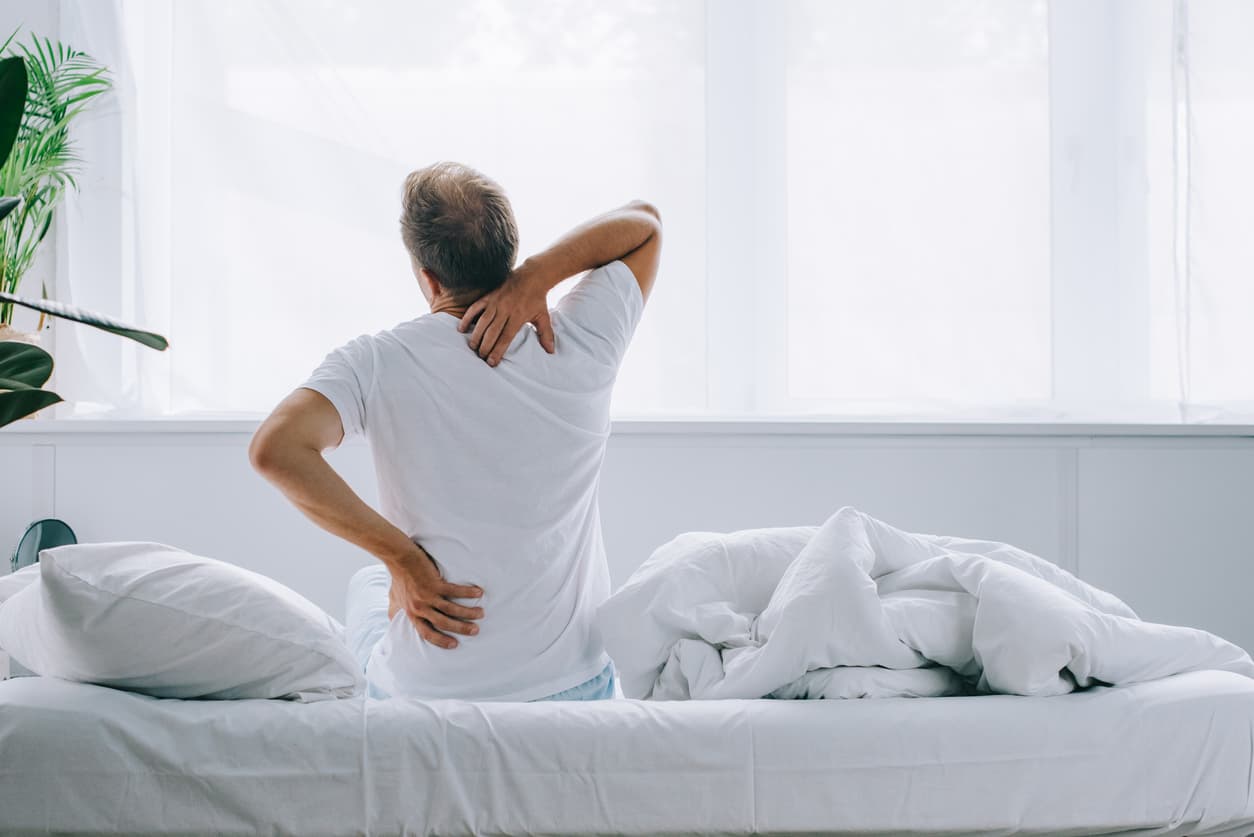If you’re switching from a traditional innerspring mattress to a memory foam mattress, you might be rethinking your bed frame. Or you might even be wondering, do you need a bed frame at all?
While it’s not absolutely essential to use a bed frame for a memory foam mattress, we highly recommend it. The right bed frame will help you get the maximum comfort and longevity out of your mattress. But memory foam mattresses are heavy and need bed frames that can support them, so your old frame might not cut it.
We’ll look at why it’s better to use a frame and the best types of bed frames for a memory foam mattress.
More than half of Americans aren’t getting enough sleep. Some may blame this on demanding work schedules, young kids, a new baby, or just having too much on their minds when they close their eyes at night.
But for many, the issue comes from an unexpected source—their bed.
Your mattress could be the barrier between you and restorative sleep. The aches and pains that keep you tossing and turning through the night may be exacerbated, or even caused, by a mattress that offers no pressure relief at critical points like your hips, shoulders, and spine.
When selecting the best mattress, scientifically-designed pressure relief and proper weight distribution should be leading considerations. Your body needs to be cradled and supported through the night so you wake feeling rested, healed, and energized every morning.
So, let’s explore pressure relief and how the right mattress can help to fix your sleep.
Key Takeaways
Pressure relief is crucial for alleviating aches, pains, and sleep disturbances caused by pressure points.
Memory foam and hybrid mattresses provide the best contouring support for hips, shoulders, and spine.
Medium-firm mattresses offer the ideal balance of pressure relief and spinal alignment for most sleepers.
Top picks include the Leesa Original, Kids Mattress, Reserve Hybrid, Legend Chill Hybrid, Legend Hybrid, and Sapira Chill Hybrid for different sleep needs.
Understanding Pressure Points: Why They Matter for Sleep Quality
Pressure points are specific areas where your body's weight concentrates against your mattress. To illustrate this, think of your body like a pair of ice skates—most of your weight is carried on just a few sharp points. On a mattress, those ‘blades’ are your hips, shoulders, knees, and spine.
Throughout the night, inadequate support at these points creates a cascade of discomfort that disrupts your sleep cycles.
The science is clear: When pressure builds at these contact points, your body responds by shifting positions to find relief. This constant micro-movement prevents you from reaching the deeper, restorative sleep stages your body requires for physical and mental recovery.
Common pressure point locations include:
Hips and pelvis - the heaviest part of most bodies
Shoulders and upper back - especially problematic for side sleepers
Knees - particularly when they press together
Spine alignment points - where vertebrae need support
Morning stiffness, joint pain, and that "unrested" feeling aren't inevitable parts of aging—they're often symptoms of inadequate pressure relief during sleep.
Who Benefits the Most from Pressure-Relieving Mattresses?
Everyone can benefit from a pressure-relieving mattress. From toddlers to retirees, we all have a delicate musculoskeletal system that needs to be supported during sleep. That being said, some groups benefit more from the right pressure-relief mattress.
Side sleepers experiencing hip and shoulder discomfort
People with arthritis or joint sensitivity
Back and stomach sleepers with spinal alignment issues
People recovering from injuries requiring gentle support
Those with higher body weight needing enhanced pressure distribution
Combination sleepers who change positions throughout the night
Waking up with joint pain, discomfort, and a feeling of muscle tightness likely isn’t just from pressure point pain. An unsupportive mattress causes a plethora of issues, ranging from pressure point issues to lower back pain to cramping. The right pressure-relieving mattress helps alleviate all these issues, giving you healing, restful sleep.
Must-Have Features for Your Next Pressure Relief Mattress
Compare these features with your current mattress. If your bed doesn’t relieve pressure and is missing the right features, then it may be time for a new sleep setup.
Memory Foam: The Gold Standard for Pressure Relief
Get ready to sleep on a supportive cloud. Memory foam mattresses are uniquely able to contour to body weight and shape, while maintaining their structure. This is possible because the material is primarily made from polyurethane, combined with special additives that enhance its density and viscosity. The best option is a mattress with multiple foam layers working together for optimal pressure distribution.
Why memory foam excels at pressure relief:
Perfectly conforms to body contours
Distributes weight evenly
Reduces pressure point concentration by 40-60%
Maintains spinal alignment
The old belief that hard intersprings are needed for nighttime support is incorrect. These traditional mattresses fail to contour to your body, meaning they won’t relieve pressure points.

The Science of Firmness and Pressure Relief
Medium-firm mattresses consistently deliver the best pressure relief for most sleepers. This isn't marketing speak—it's based on clinical sleep studies showing medium-firm surfaces provide the ideal balance of contouring and support.
However, your ideal firmness depends on several factors:
For lighter people (under 150 lbs): Medium-soft options allow adequate contouring without over-firmness
For midrange weight (150-200 lbs): Medium-firm provides perfect balance of support and pressure relief
For heavier people (over 200 lbs): Medium-firm to firm prevents excessive sinking while maintaining comfort
Advanced Materials and Technologies
Not all mattresses deliver the same advanced level of pressure relief. Look for mattresses with the following features to get a taste of luxury sleep.
Temperature Control Features: Sweaty sleepers deserve good sleep, too. Hot sleepers should look for features like cooling covers infused with chilling fibers and gel-infused memory foam layers.
High-Density Base Foam: Get extra sturdy support and durability with a stability layer made of high-density foam.
Pocketed and Zoned Coils: Hybrid mattresses (we’ll get into them later) may come with individually wrapped coils that are reinforced beneath the hips to cradle the body, promote spinal alignment, and deliver enhanced lumbar and edge support.
Top Mattress Types for Superior Pressure Relief
Clearly, picking a pressure-relieving mattress isn’t easy. There are a lot of factors to consider, so we’ve gathered a list of the top all-foam, hybrid, and dual-spring hybrid mattresses to make it easy for you.
All-Foam Mattresses
All-Foam Construction: Pure Pressure Relief
The Leesa Original Mattress is built to stop pressure pain. Instead of a single thick foam layer, Leesa utilizes three distinct foam layers that work together to provide a comfortable night's sleep. Each layer has a unique benefit.
Here's how it works:
The top layer feels soft and shapes to your body right away. The middle layer is memory foam that hugs your hips and shoulders to take away pressure. The bottom layer is firm and strong to support your whole body without sagging.
Think of it like a good sandwich—each layer has a job. Together, they make sure no part of your body gets sore from pressing too hard against the mattress.
Extra benefits you'll love:
When your partner moves, you won't feel it
Air flows through to keep you cool
The mattress stays comfortable for years
Safe materials with no harmful chemicals
For kids: The Leesa Kids Mattress uses the same three-layer design to help growing bodies sleep better and wake more rested.
Hybrid Mattresses: The Best of Memory Foam & Wrapped Springs
Introducing the lovechild between foam and pocketed coil springs—the hybrid mattress. This mattress combines a layer of coils with multiple layers of responsive foam, giving you enhanced edge support and motion isolation compared to traditional innerspring.
The zoned springs provide targeted support while allowing pressure relief at key points. With hybrid, you also get better temperature control and airflow than all-foam options.
The best-of-the-best, top-of-the-line hybrid is the Reserve Hybrid Mattress. The lumbar support is unreal. It’s the name in sleep luxury.
Dual-Spring Hybrid Mattresses
Meet the dynamic dual-spring system of your dreams. Dual-spring hybrid mattresses feature two layers of pocketed coils with varying gauges, providing customized support and pressure relief. The top layer provides gentle contouring while the bottom layer offers sturdy foundational support. Because when it comes to luxury, one layer just isn’t enough.
In the ultra-cozy Legend Chill Hybrid Mattress, over 3,788 micro and zoned springs work together in a breathable system that cradles every curve, relieves pressure, and minimizes motion disturbances.
This advanced engineering serves sleepers who:
Sleep warm and need enhanced airflow
Carry more weight and require extra support
Want long-term durability without foam breakdown
Prefer a responsive feel with pressure relief benefits
Choosing the Right Mattress Based on Your Sleep Position
Get great pressure relief based on your sleep position.
Best Options for Side Sleepers
Congratulations, you have what’s considered the healthiest sleeping position. Side sleeping promotes spinal alignment and reduces sleep apnea symptoms. The only issue is that side sleepers tend to put extra pressure on their hips and shoulders. Without the right bed, this can cause some pressure problems down the line.
Because of this, side sleepers need mattresses that are:
Medium-soft to medium-firm comfort level
Minimum 4 inches of pressure-relieving comfort layers
Memory foam or hybrid construction
Enhanced hip and shoulder zone softness
These features support a side sleeper’s spine and keep them from rolling. Mattresses like the Legend Hybrid Mattress have the ideal medium-plush comfort and plenty of supportive foam and springs to keep you in alignment all night long.
Back and Stomach Sleepers' Pressure Relief Needs
Back sleepers benefit from zoned support systems, and stomach sleepers need firmer surfaces with targeted relief. For both sleeping positions, the goal is to avoid excessive sinking that compromises spinal alignment.
The trick is balancing adequate support with pressure point comfort. For back sleepers, this may be the Legend Hybrid (again, it’s called legend for a reason), and for stomach sleepers, the Sapira Chill Hybrid Mattress at a firm comfort level is perfect.
Experience Next-Level Comfort with Leesa's Pressure-Relief Technology
Are you stuck with achy muscles and eye bags? Every person needs a mattress with pressure-relieving powers. For most, a medium-firm memory foam or hybrid mattress is able to deliver optimal support.
Shop Leesa’s sleep solutions for better pressure relief, so you can get the high-quality sleep you deserve.
Pressure Relief Mattress FAQs
What type of mattress provides the best pressure relief?
Memory foam and hybrid mattresses with substantial comfort layers deliver superior pressure relief. Look for medium-firm options with at least 3-4 inches of contouring materials. Leesa's scientifically-designed foam systems exemplify this optimal construction.
How do I know if my mattress lacks adequate pressure relief?
Common signs include morning stiffness, hip or shoulder pain, frequent position changes during sleep, and waking up feeling unrested. If you experience these symptoms regularly, your current mattress likely fails to provide adequate pressure point support.
What's the best pressure relief mattress for side sleepers?
Side sleepers benefit most from medium-soft to medium-firm mattresses with thick comfort layers. The Leesa Legend Hybrid, with its sophisticated dual-spring system and memory foam layers, excels at providing the deep contouring side sleepers require while maintaining proper spinal alignment.
Can a pressure-relieving mattress help with back pain?
Yes, when back pain stems from poor spinal alignment or pressure point buildup during sleep. Medium-firm mattresses that combine pressure relief with support—like Leesa's hybrid models—often provide significant relief by maintaining proper spine positioning while cushioning pressure points.
When should I replace my mattress for better pressure relief?
If your current mattress is over 7-8 years old, shows visible sagging, or consistently leaves you with morning pain or stiffness, it's time to invest in better pressure relief. Modern mattress technologies offer dramatically improved pressure relief compared to older designs.



